At the onset of the rise of digital music, Pioneer was one of the first Japanese manufacturers to get on the nascent market of network players, and this as soon as 2012 with its N-50 model reviewed in our columns.
Over the years, Pioneer’s range of network players has grown, releasing the NP-01, to which we awarded a Qobuzism, as well as the N-50A, the evolution of the previously cited N-50 and equipped with, among other things, a bigger display than its predecessor. Then it was the turn of the N-70A, compatible with Hi-Res digital files up to 24-bit/384 kHz and DSD64/128 and possessing, unlike the N-50 and the N-50A, an integrated Wi-Fi connection. And finally came the release of the N-30AE, a device aiming to be both high-performing and affordably priced.
The device that we’ll review in this testing ground, called the NC-50DAB, is a system known as an all-in-one, including in the same box a CD player, a network player compatible with Hi-Res files, DLNA, Airplay, Google Cast (thus able to work directly with the Qobuz App), multi-room (with a FireConnect™ app), two USB A inputs to play audio files stored on USB devices and two S/PDIF inputs (coaxial and optical)…
Its digital-to-analog conversion is compatible with Hi-Res audio up to 24-bit/192 kHz and with DSD64/128, whereas its switching amplifier can deliver up to 2 x 50 W at 4 Ω.
*********** ABOUT
Pioneer all-in-one NC-50DAB system
||About the Pioneer all-in-one NC-50DAB system|| |Type:|Amplifier with network player, S/PDIF DAC, FM/DAB tuner…| |Function:|Plays audio files stored on a computer or on an NAS server, plays Internet radios, amplifies audio signals and turns them into audible sounds| |Power:|2 x 50 W/4 &Omega| |Convertor:|ESS Hyperstream ES9016 (32-bit/384 kHz, DSD up to 11.2 MHz)| |Digital inputs:|2 x USB A, S/PDIF (coaxial and optical, 24-bit/192 kHz), RJ45 and Wi-Fi, Bluetooth| |Digital outputs:|none| |Analog inputs:| 2 x RCA stereo (including phono)| |Analog outputs:|1 x speaker, headphone output 6.35mm Jack, subwoofer pre out| |Other:|UPnP, Airplay| |Dimensions (LxHxP):|435 x 103 x 333| |Weight:|6.4 kg (14.11 lbs)| |R.R.P.:| Around 900 euros| |Distribution:|Pioneer & Onkyo Europe GmbH| *********
Presentation
The aesthetics of the NC-50DAB all-in-one system are entirely in keeping with the ones from the N-50 and N-70 network players that he’s joined in the Pioneer range. It displays a rather fine line and a pleasant façade, balanced and not overloaded. This device is available as an entirely silver box or as a black box with a brushed anodized aluminum façade.
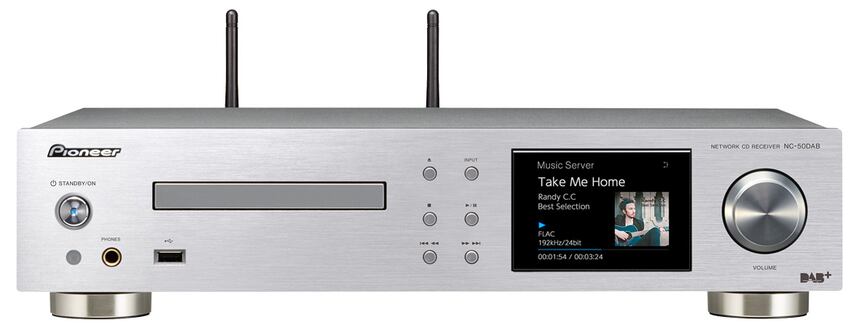
The far left-hand of the facade hosts the power button as well as the remote receiver, the 6.35mm Headphone Jack and a USB A input to plug a USB storage device (stick or hard drive) next to each other. The CD player tray occupies the central part of the left area of the façade.
Next come six keys, two on the top side allowing the ejection of the disc tray and the source selection, the other four commanding the playback of CDs or files streamed on the network, and enabling the navigation through the menus. The display near those keys will be used with all sources and will provide the corresponding information. Then, the power delivered by the amplifier will be controlled by the big volume knob. An elegant remote control will allow you to access all the device’s functionalities.
Connectivity
Some sources are included in the device, like the CD player and the tuner, or don’t require many plugs (an input for the Ethernet network and USB A inputs for the storage devices), and this impacts beneficially on the clustering of the back panel of the NC-50DAP.
To explore the latter, we’ll start by taking a look at the screw connector for the FM/DAB (DAB stands for Digital Audio Broadcasting, or digital radio, which has never been supported in France) antenna, alongside which you’ll find two RCA stereo inputs, one allocated to a vinyl turntable equipped with a moving magnet (MM) cartridge, and the other able to accept any source delivering a line signal.
You’ll then find an RCA output to connect an active subwoofer, the two S/PDIF (coaxial and optical) digital inputs, as well as the RJ45 connector to establish a wireline connection to the Ethernet network, and a second USB A plug for storage devices, that you can use if the one on the front is not able to deliver enough power, in case you’re using a hard drive, for example.
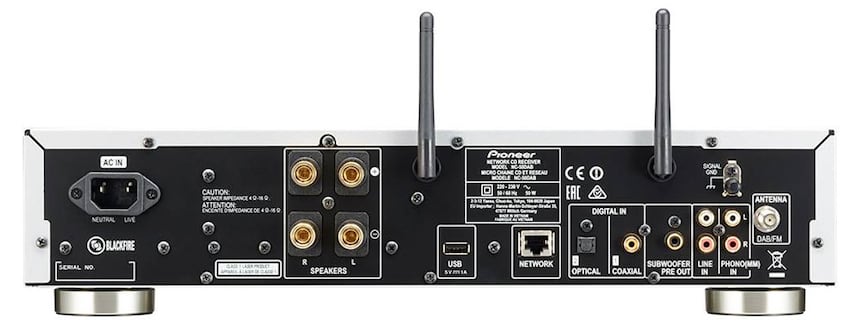
Two antennas connected to the box enable the reception of wireless signals (Wi-Fi and Bluetooth), while four beautiful gilded solid metal terminals—that work with bare wiring of a large diameter or wires equipped with banana plugs—enable speakers to be connected.
Manufacturing
Even if it’s well equipped, the inside of the Pioneer NC-50DAP all-in-one system is not packed and is both clean and tidy, with wires and connectors in order and kept in place by laminated soft metal clamps or flanges.
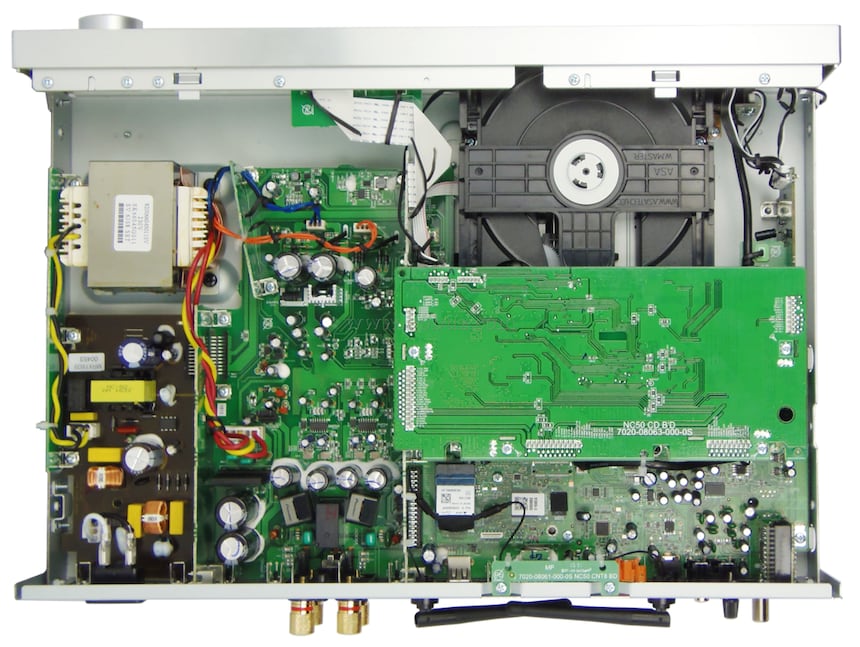
The most sensitive circuits, inputs and decoders, as well as the electronics controlling the global management and the CD player, are as far away as possible from the power supply in order to avoid any interference.
A switch-mode power supply is distributing power to the circuits in charge of the control, the display, the CD tray mechanism… while the transformer located next to it is dedicated to the analog circuits and the amplifiers.
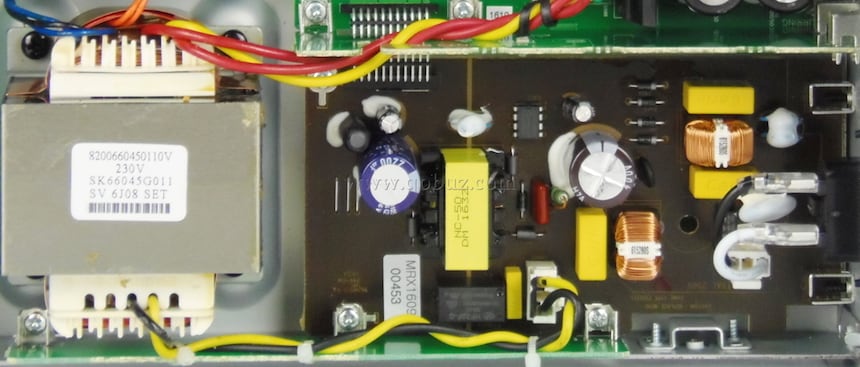
The secondary voltage coming from this transformer goes to the card on which is located the amplification. On the left side, you’ll find the symmetric power supplies and their +12V and -12V regulators, filtered by 3300 μF/35V capacitors and reserved to the operational amplifiers, as well as another power supply, probably +5V allocated to the digital circuits processing the signals.
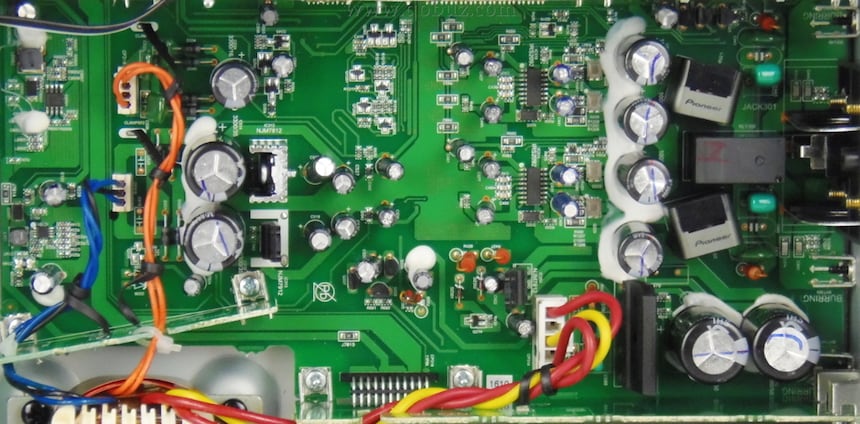
The supply of the power amplifiers is created from a molded diode bridge accepting strong electrical currents and two Samyoung 3300 μF/50V smoothing capacitors.
The switch-mode amplifiers are International Rectifier IRS2092 models, receiving incoming analog signals and running Mosfet IRF6645 transistors of the same brand enclosed in tiny metal boxes. The conversion to analog signals is handled by passive filters composed of electrolytic capacitors and selfs from Pioneer.
The inputs, analog and digital alike, are located on the same circuit board, that they also share with the network adapter and the radio tuner. The RIAA preamplifier of the phono input is articulated around a NJM4580 low-noise operational amplifier from JRC (Japan Radio Company), a model that is also used to create the low-pass filter for the subwoofer output.
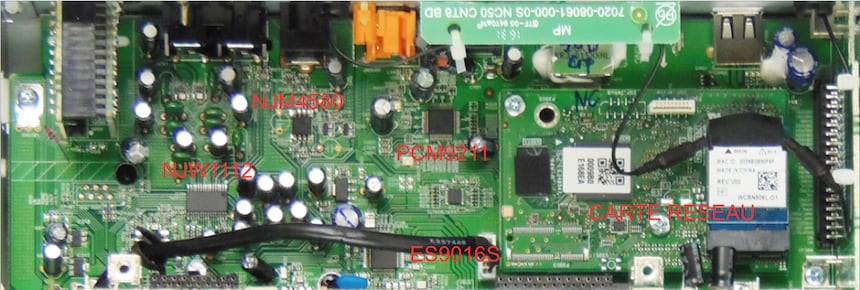
The S/PDIF digital inputs are handled by a Burr-Brown PCM9211 receiver-transmitter that also includes a digital-to-analog converter. The digital-to-analog conversion is done by a ES9016 chip from the American manufacturer ESS. It uses the Hyperstream, a proprietary technology involving a 32-bit recalculation at high frequency of each and every digital signal, as well as the Time Domain Jitter Eliminator process and possesses eight channels which, as it would seem, are used by group of four in parallel for each stereo channel to improve the signal-to-noise ratio. As for the switching of the different sources, it is done through a NJW1112 in-built selector from JRC.
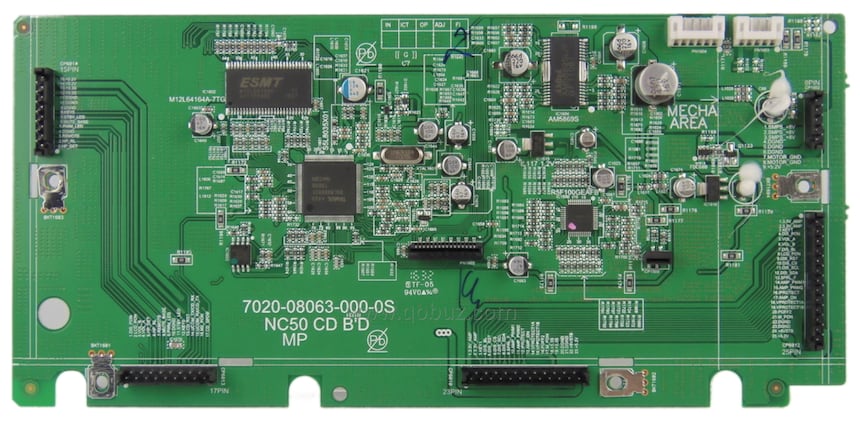
You can see below the circuit controlling the CD playback and the decoding of optical signals. This circuit is linked by connectors pluggable into several cards, among which the one hosting the microcontroller (seen below).
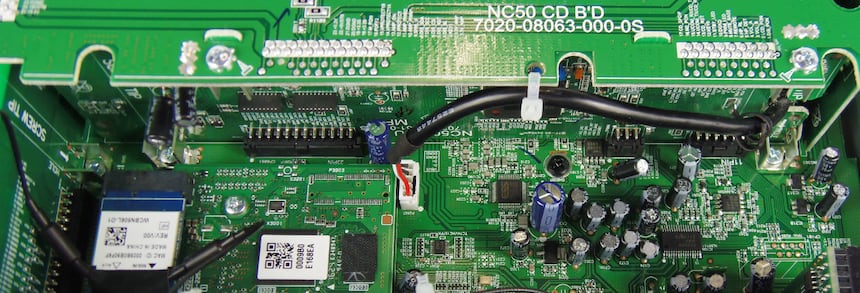
Sound
As with any all-in-one system including an amplifier, we have launched a “global” listening test by connecting our Triangle Antal Anniversary speakers to the speaker terminals of the NC-05DAB.
Listening to the Morning track from Beck’s album Morning Phase, streamed from our NAS Synology DS212 server, we perceive right away that the amplifier is full of personality and energy, even if we wouldn’t have been against a little more subtlety in the restitution!
But let’s face it, we’re dealing with a switching amplifier, and, like it’s peers, it’s particularly at ease in the bass and was eager to provide a substantial reproduction of the bass heavy titles North Star and Silent Space from the Tale Of Us album (still in network playback). The low frequencies were tightly controlled, and it wasn’t necessary to turn up the volume! As for the rest, the restitution was rather clear, and didn’t disappoint even higher in the sound spectrum.
We’ve also done some listening tests with Qobuz thanks to the UPnP functionalities of the NC-50DAP by using the BubbleUPnP app on an Android tablet.
Listening to the Othello overture from the album Dvořák, performed by the London Philharmonic Orchestra conducted by Yannick Nézet-Séguin, we’ve noticed that the dramatic force of this work was beautifully highlighted with a solid and on the whole well-adjusted restitution of the bass chords, while the cymbal intercessions, without being astounding, were convincing to say the least, with a great metal sound that was full of pizazz.
We’ve also listened to a few tracks on the Headphone Jack, firstly with the Bluetooth connection - the absence of aptX decoding was clearly perceptible, leading to a simplified sonic message with a lack of overall definition and thus with faded treble staccatos. However, it’s not the end of the world, especially since the digital amplification is behaving more or less in the same way.
But it’s quite another sonic reproduction that the Headphone Out delivers on network playback with Vivaldi’s album Gloria - Dixit Dominus interpreted by Rinaldo Alessandrini conducting the Concerto Italiano. Indeed, we find all the colours, definition, and strong chord attacks from the Concerto Italiano ensemble, with a beautiful treble staccato. This musical restitution is probably the most suitable to our ears on this all-in-one system!
To conclude, this Pioneer NC-50DAB all-in-one system is an all-around, compact and elegant device, designed with care and with extended playback capabilities, sometimes even surprising. Even if we felt there was some room for improvement on the finishing stage, its digital amplification packs a punch and never gives the listener time to get bored. Its headphone Jack can undoubtedly be used with a good pair of headphones thanks to its great sound restitution.
User Manual (in French)
It’s strange that the AIFF playback wouldn’t work on the network when it was decoded on our USB stick. Was it a problem with our NAS server? But its specs are rather impressive on the whole, with its DSD playback up to 11.2 MHz.
To follow everything that happens on Qobuz, join us on Facebook!
If you are a manufacturer, importer, retailer or key player in the digital music industry and wish to contact us, you can do it through the following email address: newstech@qobuz.com
If you’re enthusiastic about the Hi-Fi Guide column and wish to contact us, you can do it through the following email address: rubriquehifi@qobuz.com


